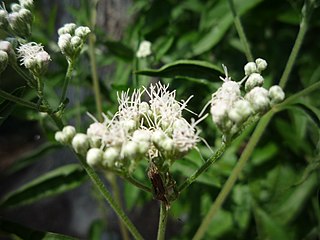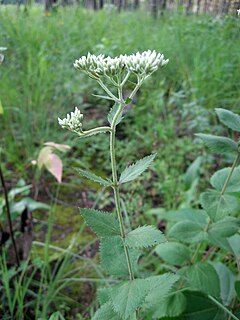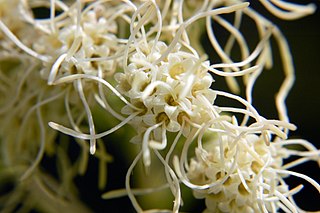
Symphyotrichum novae-angliae, the New England aster, hairy Michaelmas-daisy, or Michaelmas daisy, is a species of flowering plant in the family Asteraceae. It is a perennial, herbaceous plant native to eastern North America, and has been introduced to Europe. The seeds and nectar of this fall-flowering species are important to a wide variety of animals. Numerous cultivars have been developed and the species is a popular garden plant, especially in Europe.

Eupatorium is a genus of flowering plants in the aster family, Asteraceae, containing from 36 to 60 species depending on the classification system. Most are herbaceous perennials growing to 0.5–3 m (1.6–9.8 ft) tall. A few are shrubs. The genus is native to temperate regions of the Northern Hemisphere. Most are commonly called bonesets, thoroughworts or snakeroots in North America. The genus is named for Mithridates Eupator, king of Pontus.

Eupatorium serotinum, also known as late boneset or late thoroughwort, is a fall-blooming herbaceous plant native to North America.

Eupatorium hyssopifolium, also known as hyssopleaf thoroughwort, is a fall-blooming herbaceous plant native to North America. Like other members of the genus Eupatorium it has inflorescences containing a large number of very small flower heads, each with 5 white disc florets but no ray florets. At 0.5 to one meter tall, it is towards the shorter end of the range of heights found in Eupatorium species.

Eupatorium album, or white thoroughwort, is a herbaceous perennial plant in the sunflower family native from the eastern and southern United States, from eastern Texas to Connecticut, inland as far as Indiana.
Eupatorium leucolepis, commonly called justiceweed or white-bracted thoroughwort, is a herbaceous perennial plant in Asteraceae native from the eastern coastal United States, from New York to eastern Texas, with scattered populations inland as far as Kentucky and West Virginia.

Eupatorium mohrii, commonly called Mohr's thoroughwort, is a herbaceous perennial plant in Asteraceae native to the southeastern and south-central states of the United States, in the coastal plain from Virginia to Texas. It has also been found in the Dominican Republic.

Eupatorium resinosum, or pine barren thoroughwort, is a rare North American plant species in the sunflower family.

Eupatorium rotundifolium, commonly called roundleaf thoroughwort, is a North American species of plant in sunflower family. It native to the eastern and central United States, in all the coastal states from Maine to Texas, and inland as far as Missouri and the Ohio Valley. It is found in low, moist habitats such as wet savannas and bogs.
Eupatorium semiserratum, commonly called smallflower thoroughwort, is a North American plant species in the sunflower family. It is native to the southeastern and south-central United States, found in all the coastal states from Maryland to Texas and inland as far as Missouri and Kentucky.

Eupatorium sessilifolium, commonly called upland boneset or sessile-leaved boneset, is a North American plant species in the sunflower family. It is native to the eastern and central United States, found from Maine south to North Carolina and Alabama, and west as far as Arkansas, Kansas, and Minnesota.

Bolboschoenus novae-angliae, common names New England bulrush, and Salt march bulrush is a plant species found along the Atlantic seacoast of the United States from Alabama to Maine. It grows in brackish and salt-water marshes and estuaries along the coast.

Brickellia eupatorioides is a North American species of flowering plants in the daisy family. It is widespread in Mexico from Chihuahua to Oaxaca, and in all regions of the contiguous United States except New England, New York, and the West Coast.
Chromolaena ivifolia called ivy-leaf false thoroughwort, or ivyleaf thoroughwort, is an American species of flowering shrub in the sunflower family. It is native to North America and South America, from the southeastern United States to Argentina. Within the United States, the species is found in eastern Texas, Louisiana, southern Mississippi, southern Alabama, and Florida.
Chromolaena bigelovii called Bigelow's false thoroughwort, or Bigelow's thoroughwort, is a North American species of flowering shrub in the sunflower family. It is native to northeastern Mexico and the US State of Texas.
Eupatorium paludicola, also called swamp justiceweed, is a rare North American species of plant in sunflower family, found only in the States of North Carolina and South Carolina in the southeastern United States.
Eupatorium godfreyanum, commonly called Godfrey’s thoroughwort, is a North American species of plants in the sunflower family. It is found in the east-central United States, primarily from Pennsylvania to North Carolina, with a few isolated populations west of the Appalachians in Ohio, Kentucky, and Tennessee.
Eupatorium anomalum, commonly called Florida thoroughwort, is a North American species in the sunflower family. It grows in the southeastern United States from Alabama to Virginia. Molecular investigations suggest that it originated as a hybrid between E. serotinum and E. mohrii but it is well-established on its own as a distinct species.
Eupatorium pilosum, common name rough boneset, is a rare North American species of plant in sunflower family. It is native to the eastern and south-central United States, found in every coastal state from Massachusetts to Texas, and as far inland as Kentucky.

Liatris novae-angliae, commonly known as the New England blazing-star, is a species of flowering plant in the aster family, Asteraceae.











